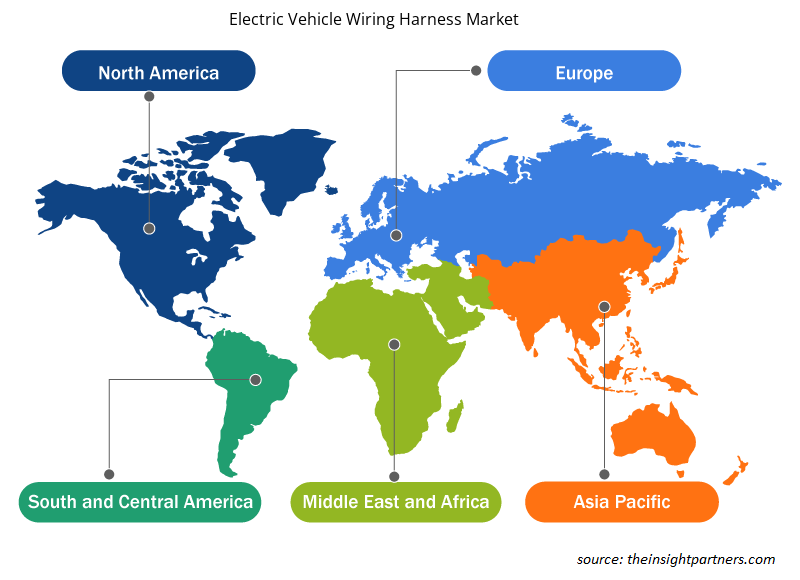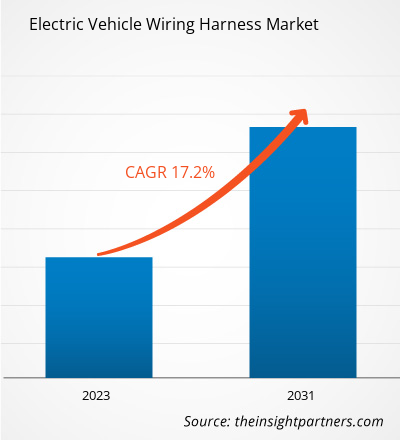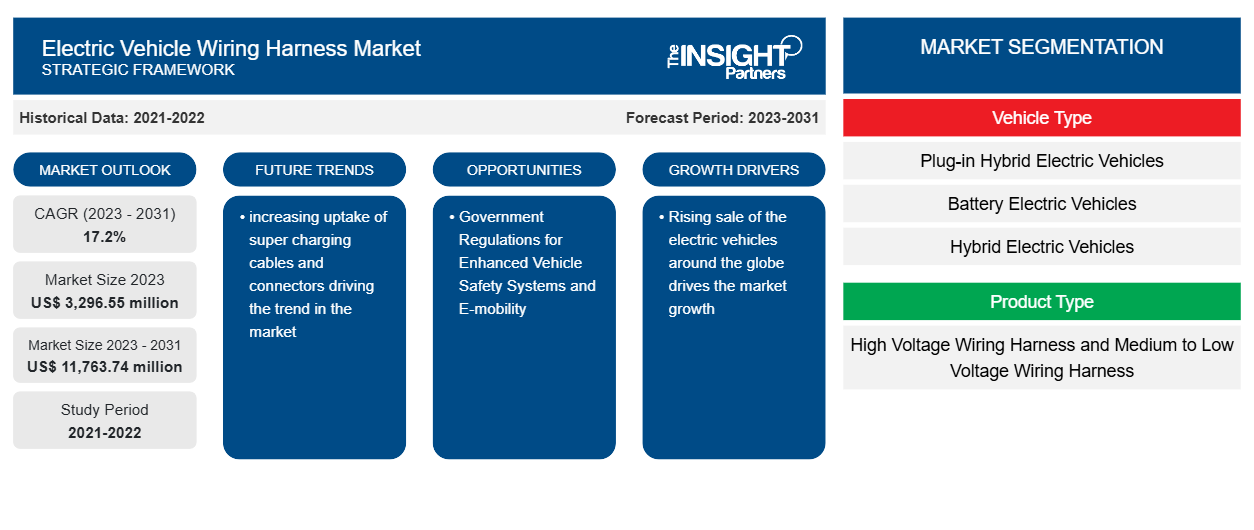Der Markt für Kabelbäume für Elektrofahrzeuge soll von 3.296,55 Millionen US-Dollar im Jahr 2023 auf 11.763,74 Millionen US-Dollar im Jahr 2031 anwachsen. Der Markt soll zwischen 2023 und 2031 eine durchschnittliche jährliche Wachstumsrate (CAGR ) von 17,2 % verzeichnen. Die zunehmende Nutzung von Super-Ladekabeln und -Anschlüssen treibt den Trend auf dem Markt voran.
Marktanalyse für Kabelbäume für Elektrofahrzeuge
Hersteller auf dem globalen Markt für Kabelbäume für Elektrofahrzeuge führen verschiedene Prozesse durch, wie Design, Montage und Umwandlung von Rohmaterial in fertige Produkte. Coroplast Fritz Müller GmbH & Co. KG, Cypress Industries, Fujikura Ltd. und Furukawa Electric Co., Ltd. gehören unter anderem zu den führenden Unternehmen auf dem Markt für Kabelbäume für Elektrofahrzeuge. Die Unternehmen bieten eine breite Produktpalette für OEMs von Plug-in-Hybridelektrofahrzeugen, batteriebetriebenen Elektrofahrzeugen, Hybridelektrofahrzeugen und Brennstoffzellenelektrofahrzeugen . Die Endverbraucher umfassen eine große Anzahl von Kunden, vom Käufer von Privatfahrzeugen bis hin zu Flottenbetreibern. Der zunehmende Fokus auf die Verbesserung des Kraftstoffverbrauchs von Fahrzeugen, die Steigerung der Produktion von Elektrofahrzeugen und die hohe Nachfrage nach leichten Kabelbäumen dürften den Unternehmen, die in diesen Markt einsteigen möchten, erhebliche Chancen bieten.
Marktübersicht für Kabelbäume für Elektrofahrzeuge
Das Ökosystem des Marktes für Kabelbäume für Elektrofahrzeuge besteht aus den folgenden Interessengruppen: Rohstofflieferanten, Kabelbaumhersteller, OEMs und Endverbraucher. Wichtige Akteure nehmen bedeutende Positionen in den verschiedenen Knotenpunkten des Ökosystems des Marktes für Kabelbäume für Elektrofahrzeuge ein. Die Rohstofflieferanten liefern die Komponenten wie Aluminium und Kupfer, um den Kabelbaum herzustellen. Zu den Komponenten eines Kabelbaums für Elektrofahrzeuge gehören Steckverbinder, Klemmen, Schlösser, Drähte, Kabel und Außenabdeckungen.
Passen Sie diesen Bericht Ihren Anforderungen an
Sie erhalten kostenlos individuelle Anpassungen an jedem Bericht, einschließlich Teilen dieses Berichts oder einer Analyse auf Länderebene, eines Excel-Datenpakets sowie tolle Angebote und Rabatte für Start-ups und Universitäten.
-
Holen Sie sich die wichtigsten Markttrends aus diesem Bericht.Dieses KOSTENLOSE Beispiel umfasst eine Datenanalyse von Markttrends bis hin zu Schätzungen und Prognosen.
Treiber und Chancen auf dem Markt für Kabelbäume für Elektrofahrzeuge
Steigende Nachfrage nach leichten Gurten
Technologische Fortschritte und die zunehmende Produktion von Elektrofahrzeugen ( EV ) führen zu einer wachsenden Nachfrage nach leichten Kabelbäumen, um Gewichtsreduzierung und verbesserte Fahrzeugverpackung zu erreichen. Die Integration fortschrittlicher Funktionen in autonome Personenkraftwagen und leichte Nutzfahrzeuge wird das Marktwachstum im Prognosezeitraum voraussichtlich weiter fördern.
Wichtige Marktteilnehmer konzentrieren sich auf die Entwicklung von Leitermaterialien wie CuAg (Kupfer/Silber), CuSn (Kupfer/Zinn) und CuMg (Kupfer/Magnesium), um das aktuelle Design von Bordnetzen zu optimieren. Kupferleiter sind aufgrund ihrer hervorragenden elektrischen Leitfähigkeit und Sicherheit sowie ihrer Vorteile bei der Gewichtsreduzierung der gängigste Werkstoff in der Branche. Die zunehmende Forschung und Entwicklung zur Verringerung des Metallgehalts trägt dazu bei, das Gewicht zu reduzieren und den Kraftstoffverbrauch des Fahrzeugs insgesamt zu senken. Darüber hinaus gewinnen leichte, umweltfreundliche Kabelbaumlösungen wie Hochspannungskabelbaumsysteme für Hybrid- und Plug-in-Fahrzeuge ebenfalls schnell an Bedeutung.
Staatliche Vorschriften für verbesserte Fahrzeugsicherheitssysteme und Elektromobilität
In Nordamerika werden Regierungsinitiativen, Bundesrichtlinien und Programme für verschiedene Branchen den Markt für Kabelbäume für Elektrofahrzeuge voraussichtlich ankurbeln. Die USA, Kanada und Mexiko haben das Handelsabkommen NAFTA unterzeichnet. Das Handelsabkommen hilft den Automobilherstellern bei der Erhöhung der Zahl ihrer Produktionsanlagen und einer verbesserten Lieferkette für Autoteile. Die steigende Nachfrage nach Hybrid- und Elektrofahrzeugen und die zunehmende Elektrifizierung von Fahrzeugen sind die Hauptfaktoren, die den globalen Markt für Kabelbäume für Elektrofahrzeuge ankurbeln. Strenge Emissionsnormen für Fahrzeuge zwingen OEMs dazu, Hybrid- und Elektrofahrzeuge herzustellen, um den Ausstoß schädlicher Gase zu verringern. Das US-Verkehrsministerium hat die CAFE-Standards (Corporate Average Fuel Economy) für Fahrzeuge festgelegt. Die Standards des Canadian National Safety Code (NSC) regeln Nutzfahrzeuge , Fahrer und Kraftverkehrsunternehmen in Kanada. Der NSC ist ein Kodex mit Mindestleistungsstandards für den sicheren Betrieb von Nutzfahrzeugen.
Marktbericht über Kabelbäume für Elektrofahrzeuge – Segmentierungsanalyse
Wichtige Segmente, die zur Ableitung der Marktanalyse für Kabelbäume für Elektrofahrzeuge beigetragen haben, sind Fahrzeugtyp, Produkttyp, Materialtyp und Geografie.
- Basierend auf dem Fahrzeugtyp ist der Markt in Plug-in-Hybrid-Elektrofahrzeuge (PHEV), batteriebetriebene Elektrofahrzeuge (BEV), Hybrid-Elektrofahrzeuge (HEV) und Brennstoffzellen-Elektrofahrzeuge (FCBEV) unterteilt. Unter diesen haben batteriebetriebene Elektrofahrzeuge (BEV) im Jahr 2023 den größten Anteil, was auf den weltweit steigenden Absatz von Elektrofahrzeugen zurückzuführen ist.
- Je nach Produkttyp ist der Markt in Hochspannungskabelbäume und Mittel- bis Niederspannungskabelbäume unterteilt. Darunter haben Mittel- bis Niederspannungskabelbäume im Jahr 2023 einen größeren Anteil.
- Basierend auf dem Materialtyp ist der Markt in kupferummantelte Drähte, Drähte aus Aluminiumlegierungen, Glasfasern, Kunststoff-Glasfasern und andere unterteilt. Unter diesen wächst der Aluminiumlegierungsdraht im Prognosezeitraum rasant.
Marktanteilsanalyse für Kabelbäume für Elektrofahrzeuge nach geografischer Lage
Der geografische Umfang des Marktberichts über Kabelbäume für Elektrofahrzeuge ist hauptsächlich in fünf Regionen unterteilt: Nordamerika, Asien-Pazifik, Europa, Naher Osten und Afrika sowie Süd- und Mittelamerika.
Der asiatisch-pazifische Raum hat den größten Anteil am Markt für Kabelbäume für Elektrofahrzeuge, was auf den gestiegenen Absatz von Elektrofahrzeugen in dieser Region zurückzuführen ist. Die steigende Nachfrage der Verbraucher nach teuren Funktionen in Automobilen ermutigt die Hersteller, in hochtechnologische Lösungen zu investieren. Die Autoindustrie war das erste wirtschaftliche Opfer von COVID-19 in China, als wichtige Produktionsstätten und Fertigungsanlagen für die Automobilindustrie geschlossen wurden. Der Automobilmarkt im asiatisch-pazifischen Raum erholte sich 2021 weiter stark. Branchenexperten erwarten, dass sich die Margen der Automobilhersteller im Geschäftsjahr 2022 verbessern werden. Die Markterholung fördert das Wachstum von Kabelbaumlösungen für Elektrofahrzeuge. In den meisten Ländern sind Subventionen aufgrund der höheren Fahrzeugkosten ein wichtiges Instrument zur Aufrechterhaltung der Elektrofahrzeugpolitik. Die japanische Regierung hat im Januar 2021 77,1 Millionen US-Dollar an Elektrofahrzeugsubventionen bereitgestellt, um den Absatz von Elektrofahrzeugen anzukurbeln. Auf dem Markt für Elektrofahrzeuge in China, Japan und Südkorea entstehen eine Reihe neuer Risikokapitalfirmen, die dem Markt für Kabelbäume für Elektrofahrzeuge lukrative Wachstumschancen bieten dürften.
Regionale Einblicke in den Markt für Kabelbäume für Elektrofahrzeuge
Die regionalen Trends und Faktoren, die den Markt für Kabelbäume für Elektrofahrzeuge im gesamten Prognosezeitraum beeinflussen, wurden von den Analysten von Insight Partners ausführlich erläutert. In diesem Abschnitt werden auch die Marktsegmente und die Geografie für Kabelbäume für Elektrofahrzeuge in Nordamerika, Europa, im asiatisch-pazifischen Raum, im Nahen Osten und Afrika sowie in Süd- und Mittelamerika erörtert.

- Erhalten Sie regionale Daten zum Markt für Kabelbäume für Elektrofahrzeuge
Umfang des Marktberichts zum Kabelbaum für Elektrofahrzeuge
| Berichtsattribut | Details |
|---|---|
| Marktgröße im Jahr 2023 | 3.296,55 Millionen US-Dollar |
| Marktgröße bis 2031 | 11.763,74 Millionen US-Dollar |
| Globale CAGR (2023 - 2031) | 17,2 % |
| Historische Daten | 2021-2022 |
| Prognosezeitraum | 2023–2031 |
| Abgedeckte Segmente |
Nach Fahrzeugtyp
|
| Abgedeckte Regionen und Länder |
Nordamerika
|
| Marktführer und wichtige Unternehmensprofile |
|
Marktteilnehmerdichte: Der Einfluss auf die Geschäftsdynamik
Der Markt für Kabelbäume für Elektrofahrzeuge wächst rasant. Dies wird durch die steigende Nachfrage der Endnutzer aufgrund von Faktoren wie sich entwickelnden Verbraucherpräferenzen, technologischen Fortschritten und einem größeren Bewusstsein für die Vorteile des Produkts vorangetrieben. Mit der steigenden Nachfrage erweitern Unternehmen ihr Angebot, entwickeln Innovationen, um die Bedürfnisse der Verbraucher zu erfüllen, und nutzen neue Trends, was das Marktwachstum weiter ankurbelt.
Die Marktteilnehmerdichte bezieht sich auf die Verteilung der Firmen oder Unternehmen, die in einem bestimmten Markt oder einer bestimmten Branche tätig sind. Sie gibt an, wie viele Wettbewerber (Marktteilnehmer) in einem bestimmten Marktraum im Verhältnis zu seiner Größe oder seinem gesamten Marktwert präsent sind.
Die wichtigsten auf dem Markt für Kabelbäume für Elektrofahrzeuge tätigen Unternehmen sind:
- Coroplast Fritz Müller GmbH & Co. KG
- Fujikura Ltd.
- Furukawa Electric Co. Ltd.
- Motherson Sumi Systems Ltd.
- Nexans Autoelectric GmbH
Haftungsausschluss : Die oben aufgeführten Unternehmen sind nicht in einer bestimmten Reihenfolge aufgeführt.

- Überblick über die wichtigsten Akteure auf dem Markt für Kabelbäume für Elektrofahrzeuge
Neuigkeiten und aktuelle Entwicklungen zum Markt für Kabelbäume für Elektrofahrzeuge
Der Markt für Kabelbäume für Elektrofahrzeuge wird durch die Erhebung qualitativer und quantitativer Daten nach Primär- und Sekundärforschung bewertet, die wichtige Unternehmensveröffentlichungen, Verbandsdaten und Datenbanken umfasst. Nachfolgend sind einige der Entwicklungen auf dem Markt für Kabelbäume für Elektrofahrzeuge aufgeführt:
- Delphi kündigt die Einführung seiner neuen BEV-Bremsbeläge an, die speziell auf die Anforderungen von BEV-Anwendungen zugeschnitten sind. Basierend auf detaillierten Vergleichen gehört dieses Sortiment heute zu den umfassendsten der Welt und deckt die beliebtesten Modelle im unabhängigen Ersatzteilmarkt ab. Zu den Fahrzeugen gehören der Nissan Leaf und das Tesla Model S/Model 3 sowie die neuesten Modelle wie BMW i4/iX, Mercedes EQC/EQEE/QS und Porsche Taycan/Cross Turismo. Mit der Einführung von 52 Teilenummern, die 2,7 Millionen in Europa in Betrieb befindliche Fahrzeuge abdecken, bietet Delphi Werkstätten eine umfassende Servicemöglichkeit. (Quelle: Unternehmenswebsite, Februar 2024)
- Allied Nippon hat EV+ auf den Markt gebracht, eine brandneue, voll ausgestattete Bremsbelagserie für Elektrofahrzeuge. (Quelle: Pressemitteilung, Juni 2023)
Marktbericht zum Kabelbaum für Elektrofahrzeuge – Umfang und Ergebnisse
Der Bericht „Marktgröße und Prognose für Kabelbäume für Elektrofahrzeuge (2021–2031)“ bietet eine detaillierte Analyse des Marktes, die die folgenden Bereiche abdeckt:
- Marktgröße und Prognose für Kabelbäume für Elektrofahrzeuge auf globaler, regionaler und Länderebene für alle wichtigen Marktsegmente, die im Rahmen des Projekts abgedeckt sind
- Markttrends für Kabelbäume für Elektrofahrzeuge sowie Marktdynamik wie Treiber, Einschränkungen und wichtige Chancen
- Detaillierte PEST- und SWOT-Analyse
- Marktanalyse für Kabelbäume für Elektrofahrzeuge, die wichtige Markttrends, globale und regionale Rahmenbedingungen, wichtige Akteure, Vorschriften und aktuelle Marktentwicklungen umfasst
- Branchenlandschaft und Wettbewerbsanalyse, die die Marktkonzentration, Heatmap-Analyse, prominente Akteure und aktuelle Entwicklungen auf dem Markt für Kabelbäume für Elektrofahrzeuge umfasst
- Detaillierte Firmenprofile
- Historische Analyse (2 Jahre), Basisjahr, Prognose (7 Jahre) mit CAGR
- PEST- und SWOT-Analyse
- Marktgröße Wert/Volumen – Global, Regional, Land
- Branchen- und Wettbewerbslandschaft
- Excel-Datensatz
Aktuelle Berichte
Verwandte Berichte
Erfahrungsberichte
Grund zum Kauf
- Fundierte Entscheidungsfindung
- Marktdynamik verstehen
- Wettbewerbsanalyse
- Kundeneinblicke
- Marktprognosen
- Risikominimierung
- Strategische Planung
- Investitionsbegründung
- Identifizierung neuer Märkte
- Verbesserung von Marketingstrategien
- Steigerung der Betriebseffizienz
- Anpassung an regulatorische Trends























 Kostenlose Probe anfordern für - Markt für Kabelbäume für Elektrofahrzeuge
Kostenlose Probe anfordern für - Markt für Kabelbäume für Elektrofahrzeuge